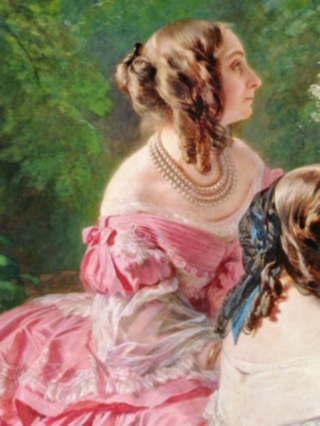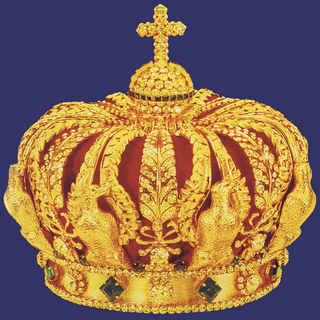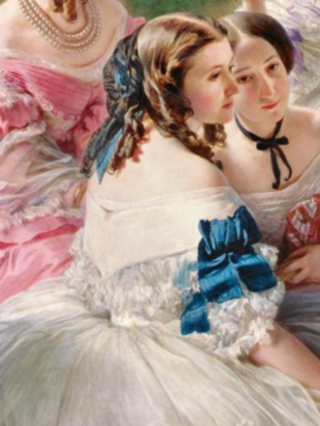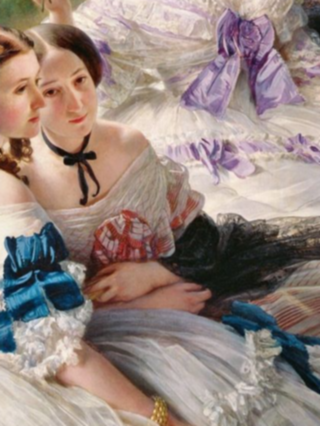
Eugénie de Montijo was Empress of the French from her marriage to Napoleon III on 30 January 1853 until he was overthrown on 4 September 1870. From 28 July to 4 September 1870, she was the de facto head of state of France.

The Tuileries Palace was a royal and imperial palace in Paris which stood on the right bank of the Seine, directly in the west-front of the Louvre Palace. It was the Parisian residence of most French monarchs, from Henry IV to Napoleon III, until it was burned by the Paris Commune in 1871.

Franz Xaver Winterhalter was a German painter and lithographer, known for his flattering portraits of royalty and upper-class society in the mid-19th century. His name has become associated with fashionable court portraiture. Among his best known works are Empress Eugénie Surrounded by her Ladies in Waiting (1855) and the portraits he made of Empress Elisabeth of Austria (1865).

The Crown of Empress Eugénie is the consort crown that was made for Eugénie de Montijo, empress consort of Napoleon III, Emperor of the French. Although neither she or her husband had a coronation ceremony, a crown was specially created for her on the occasion of the 1855 Exposition Universelle in Paris. The gold crown is set with diamonds and emeralds in eagle and palmette motifs, and is topped by a monde.

Édouard Louis Dubufe was a French portrait painter.

The Château de Saint-Cloud was a château in France, built on a site overlooking the Seine at Saint-Cloud in Hauts-de-Seine, about 5 kilometres west of Paris. On the site of the former palace is the state-owned Parc de Saint-Cloud.

Pauline Marie Ghislaine de Bassano, née van der Linden d'Hooghvorst, was a French courtier. She served as dame d'honneur to Empress Eugénie de Montijo in 1853–1867.

Anne Debelle, Princesse d'Essling, was a French courtier. She served as Grand-Maitresse to Empress Eugénie de Montijo in 1853–1870.

Augusta Amélie Maximilienne Jacqueline Bonaparte was a French-Italian Napoleonic princess.

Portrait of Napoleon III is an oil painting of 1861 by the French painter Hippolyte Flandrin, depicting France's Emperor Napoleon III standing in his Grand Cabinet. It is held at the Musée de l'Histoire de France, in Paris. At its first presentation in the Universal Exhibition in 1862, the painting attracted praise for its true-to-life representation of Napoleon III.

The Crown of Napoleon III was a crown that was made for Napoleon III, Emperor of the French. Although he did not have a coronation ceremony, a crown was made for him on the occasion of the 1855 Exposition Universelle in Paris. The gold crown had eagle-shaped arches and others in the form of palmettes, set with diamonds, and topped by a monde.

Jane Mary Thorne, baronne de Pierres was a French courtier of American origin. She served as lady-in-waiting to the empress of France, Eugénie de Montijo.

Claire Emilie MacDonell, Marquise de Las Marismas de Guadalquivir was a courtier of the French imperial court. She served as lady-in-waiting to Empress Eugénie de Montijo from 1853 to 1870.

Adrienne de Villeneuve-Bargemont, comtesse de Montebello (1826-1870), was a French courtier. She served as lady-in-waiting to the empress of France, Eugénie de Montijo.

Anne Mortier de Trévise, marquise de Latour-Maubourg (1829-1900), was a French courtier. She served as lady-in-waiting to the empress of France, Eugénie de Montijo.

Louise Poitelon du Tarde, vicomtesse de Lezay-Marnésia (1826–1891), was a French courtier. She served as lady-in-waiting to the empress of France, Eugénie de Montijo.

Nathalie de Ségur, baronne de Malaret was a French courtier. She served as lady-in-waiting to the empress of France, Eugénie de Montijo.

Empress Eugénie Surrounded by her Ladies in Waiting is an oil on canvas painting by the German artist Franz Xaver Winterhalter completed in 1855. It features depictions of the Empress of France, Eugénie de Montijo, and eight of her ladies-in-waiting. The painting was displayed at the Palace of Fontainebleau during the regime of Eugénie's husband, Napoleon III. After Eugénie's exile to England, the painting was given to her, and later displayed in the entrance to her house at Farnborough Hill. It is currently on display at the Château de Compiègne.

Amélie Carette née Bouvet (1839–1926) was a French memoir writer and courtier.

The Chinese Museum or musée chinois is a section of the Palace of Fontainebleau that keeps artifacts from Qing dynasty China, the Kingdom of Siam, and other Asian countries, including diplomatic gifts and plunder from the Second Opium War. Opened in 1863 by Empress Eugénie, it is one of the world's oldest museums specifically dedicated to Asian art.




















